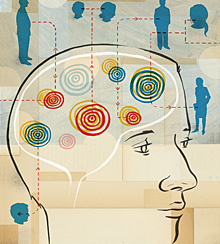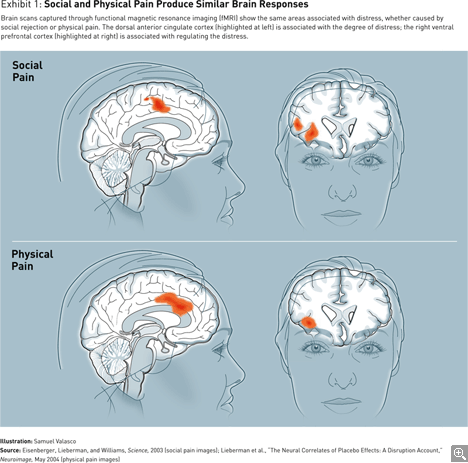Neuroscience research is revealing the social nature of the high-performance workplace.
by David Rock
Naomi Eisenberger, a leading social neuroscience researcher at the University of California at Los Angeles (UCLA), wanted to understand what goes on in the brain when people feel rejected by others.
She designed an experiment in which volunteers played a computer game called Cyberball while having their brains scanned by a functional magnetic resonance imaging (fMRI) machine.
Cyberball hearkens back to the nastiness of the school playground. “People thought they were playing a ball-tossing game over the Internet with two other people,” Eisenberger explains. “They could see an avatar that represented themselves, and avatars [ostensibly] for two other people. Then, about halfway through this game of catch among the three of them, the subjects stopped receiving the ball and the two other supposed players threw the ball only to each other.”
Even after they learned that no other human players were involved, the game players spoke of feeling angry, snubbed, or judged, as if the other avatars excluded them because they didn’t like something about them.
This reaction could be traced directly to the brain’s responses. “When people felt excluded,” says Eisenberger, “we saw activity in the dorsal portion of the anterior cingulate cortex — the neural region involved in the distressing component of pain, or what is sometimes referred to as the ‘suffering’ component of pain. Those people who felt the most rejected had the highest levels of activity in this region.” In other words, the feeling of being excluded provoked the same sort of reaction in the brain that physical pain might cause. (See Exhibit 1.)
Eisenberger’s fellow researcher Matthew Lieberman, also of UCLA, hypothesizes that human beings evolved this link between social connection and physical discomfort within the brain “because, to a mammal, being socially connected to caregivers is necessary for survival.” This study and many others now emerging have made one thing clear: The human brain is a social organ. Its physiological and neurological reactions are directly and profoundly shaped by social interaction. Indeed, as Lieberman puts it, “Most processes operating in the background when your brain is at rest are involved in thinking about other people and yourself.”
This presents enormous challenges to managers. Although a job is often regarded as a purely economic transaction, in which people exchange their labor for financial compensation, the brain experiences the workplace first and foremost as a social system.
Like the experiment participants whose avatars were left out of the game, people who feel betrayed or unrecognized at work — for example, when they are reprimanded, given an assignment that seems unworthy, or told to take a pay cut — experience it as a neural impulse, as powerful and painful as a blow to the head. Most people who work in companies learn to rationalize or temper their reactions; they “suck it up,” as the common parlance puts it.
But they also limit their commitment and engagement. They become purely transactional employees, reluctant to give more of themselves to the company, because the social context stands in their way.
Leaders who understand this dynamic can more effectively engage their employees’ best talents, support collaborative teams, and create an environment that fosters productive change. Indeed, the ability to intentionally address the social brain in the service of optimal performance will be a distinguishing leadership capability in the years ahead.
Triggering the Threat Response
One critical thread of research on the social brain starts with the “threat and reward” response, a neurological mechanism that governs a great deal of human behavior.
When you encounter something unexpected — a shadow seen from the corner of your eye or a new colleague moving into the office next door — the limbic system (a relatively primitive part of the brain, common to many animals) is aroused.
Neuroscientist Evian Gordon refers to this as the “minimize danger, maximize reward” response; he calls it “the fundamental organizing principle of the brain.”
Neurons are activated and hormones are released as you seek to learn whether this new entity represents a chance for reward or a potential danger. If the perception is danger, then the response becomes a pure threat response — also known as the fight or flight response, the avoid response, and, in its extreme form, the amygdala hijack, named for a part of the limbic system that can be aroused rapidly and in an emotionally overwhelming way.
For more, go to:


No comments:
Post a Comment